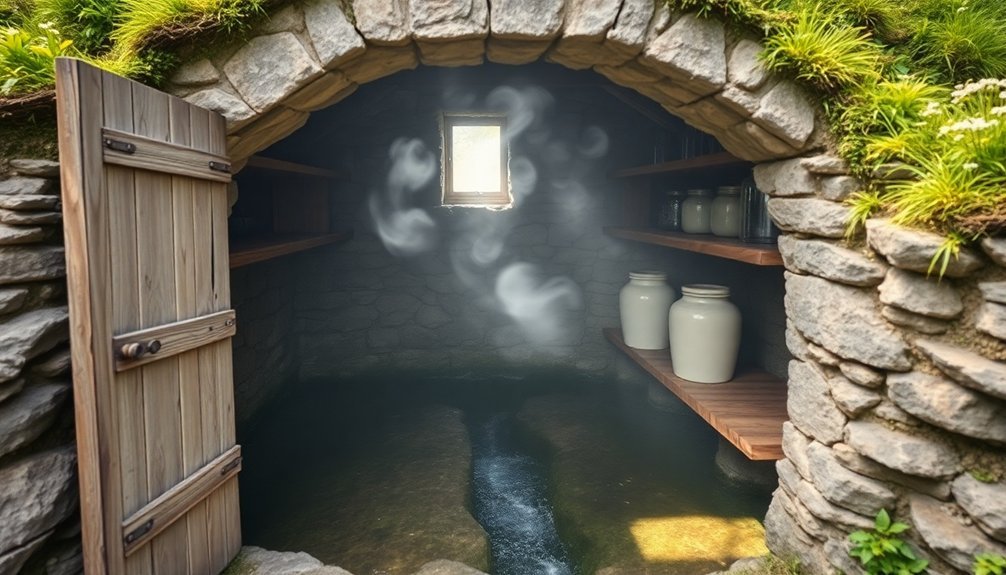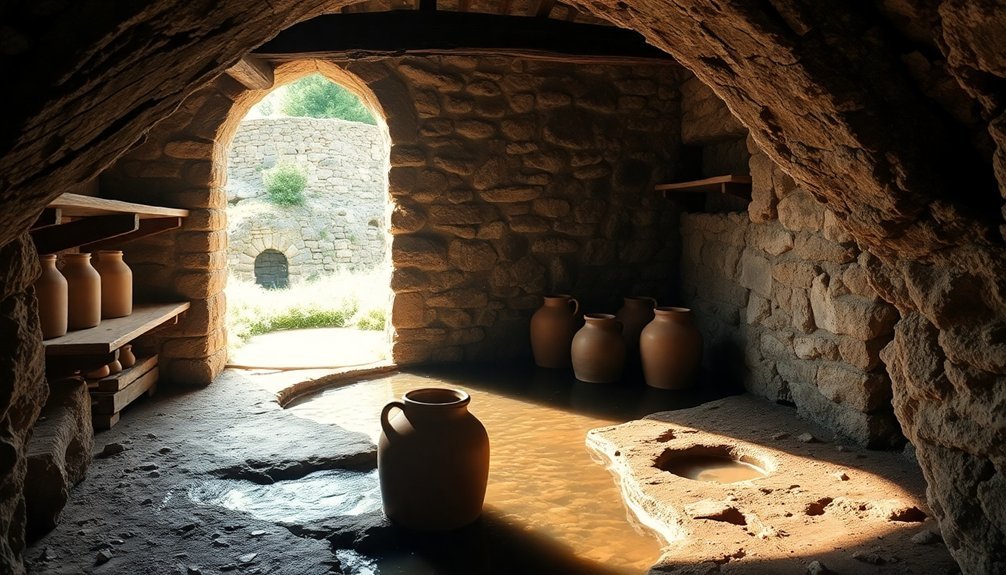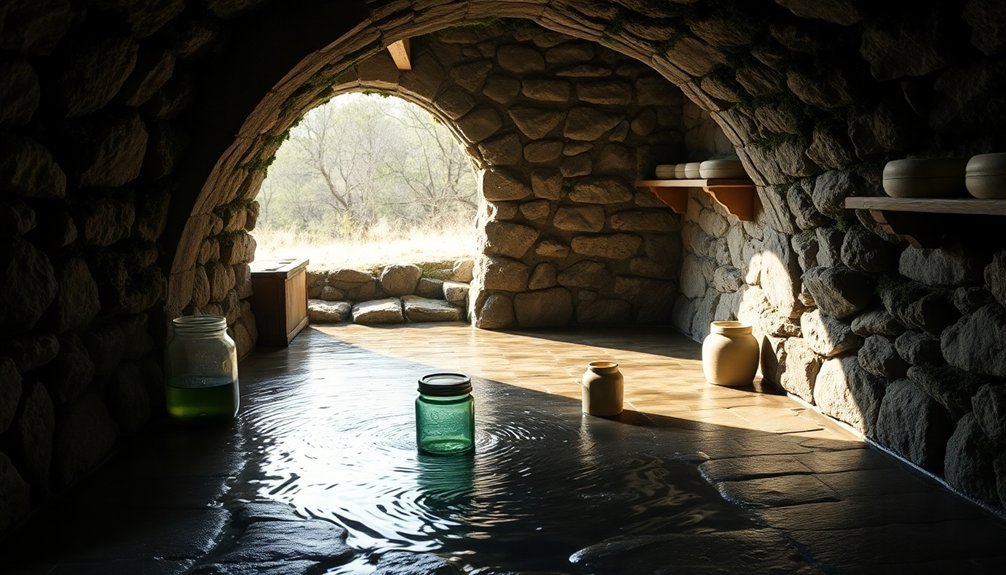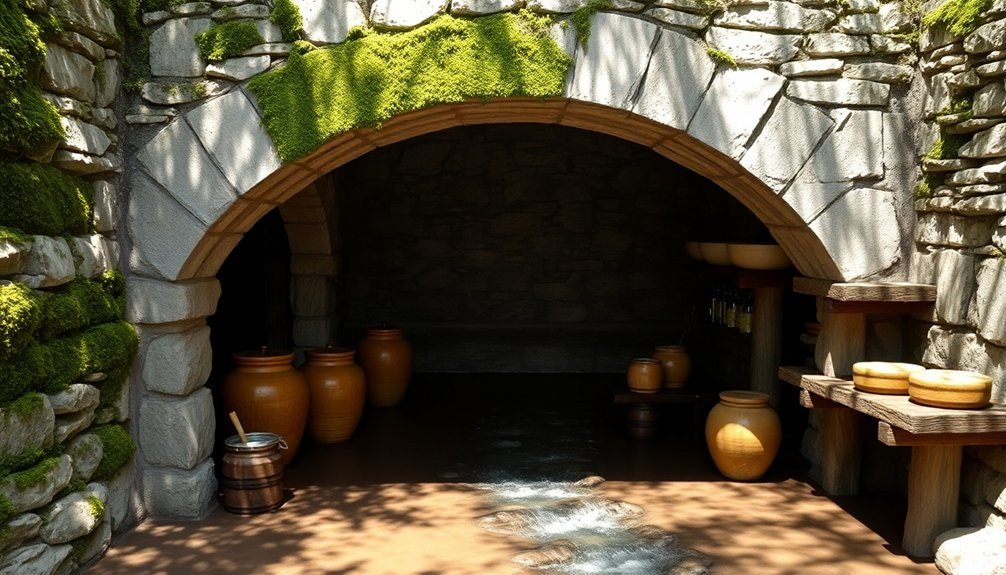Spring houses keep your food cold by harnessing the natural power of underground springs, which maintain a consistent 50°F year-round. You'll find these structures built into earthen banks, where thick stone walls and surrounding soil provide excellent insulation. The clever engineering allows cold spring water to flow through channels, absorbing heat from the air and stored items while creating a natural cooling system. Your food stays fresh through strategic placement – dairy products near water channels and preserved goods on built-in shelves along the walls. This time-tested method offers an efficient, off-grid solution that's still relevant for modern homesteaders looking to reduce their energy footprint.
Natural Cold Water Engineering

Throughout human history, spring houses have exemplified ingenious natural cooling engineering by harnessing the power of underground springs. When you tap into these natural water sources, you'll find they maintain a consistent temperature of around 50°F year-round, creating an ideal environment for food preservation without electricity.
The engineering behind spring houses relies on basic heat exchange principles. As the cold spring water flows through channels built along the interior walls, it absorbs heat from the surrounding air and stored items. This natural filtration process through the aquifer provides remarkably consistent water quality compared to surface water sources.
You'll notice the stone construction amplifies this effect, as it helps maintain steady temperatures and provides natural insulation. When you build a spring house against a hillside, you're taking advantage of additional earth-based insulation properties.
The water flow system you'll find in a spring house isn't random – it's carefully designed with small channels that direct the spring water strategically throughout the structure. This creates a continuous cooling effect as the water moves through the building.
You're fundamentally working with nature's own refrigeration system, where the consistent underground water temperature provides reliable cooling power throughout all seasons.
Building Into Earth Banks
Building your spring house into an earth bank provides exceptional natural insulation, as the surrounding soil maintains a more consistent temperature than the air throughout the year.
You'll find that granular soils like sand and gravel offer the best stability for your structure while allowing proper drainage around the walls. Consistent practices in soil preparation and ripping will ensure optimal stability of your spring house foundation.
To maximize the earth's stabilizing properties, you can incorporate compacted soil layers and strategically placed boulders around the building's perimeter.
Natural Insulation Benefits
When constructed into earthen banks, springhouses harness nature's remarkable insulating properties to maintain consistent temperatures between 40 to 50 degrees Fahrenheit year-round. The thick stone and earth walls, typically one to two feet wide, act as natural insulators by slowly absorbing and releasing heat.
While these materials don't have high insulation values individually, their thermal mass properties, combined with the continuous flow of cold water, create an effective cooling system. The natural composition helps create improved energy efficiency throughout the structure.
You'll find that these natural materials offer significant advantages over modern insulation methods. They're incredibly durable, requiring minimal maintenance and experiencing less performance degradation over time.
The walls resist damage from moisture, insects, and rodents, ensuring a longer lifespan and fewer repairs.
What's more, you're making an environmentally sound choice. Natural insulation materials are renewable and biodegradable, consuming less energy during their production and installation.
They'll help you reduce your carbon footprint while improving indoor air quality through better moisture control. The passive cooling design eliminates the need for external energy sources, saving you money on utility bills while preserving your food naturally and efficiently.
Earth Stability Features
According to successful site selection principles, springhouses built into earth banks require careful consideration of both slope and orientation. You'll find that south-facing slopes work best in regions with longer winters, while north-facing slopes prove more effective in areas with hot summers. The earth's natural stability provides significant structural advantages for your springhouse.
When you build into an earth bank, you're gaining natural protection against severe weather conditions and temperature fluctuations. The surrounding earth acts as a shield against high winds, hailstorms, and even tornadoes. You'll need less maintenance on the exterior walls, and you'll benefit from enhanced soundproofing.
| Feature | Benefit | Climate Consideration |
|---|---|---|
| Earth Berming | Temperature Stabilization | Most effective in extreme climates |
| Slope Position | Natural drainage | Works best on modest to steep slopes |
| Bank Orientation | Solar gain control | South-facing for cold regions |
| Structural Support | Weather protection | Essential in storm-prone areas |
The earth's thermal mass helps maintain consistent temperatures year-round, making your springhouse more energy-efficient. You'll want to guarantee proper construction techniques and suitable fill materials to enhance the structure's integrity while maximizing these natural advantages.
Traditional Food Storage Layout

Throughout the interior of a spring house, careful organization maximizes both space and cooling efficiency. You'll find milk-filled pails and large cuts of meat suspended from the rafters, keeping them elevated and cooled by the rising cold air.
Along the walls, built-in shelves hold stoneware crocks containing pickled vegetables, preserved fruits, and corned meats.
Water management plays an essential role in the storage layout. You'll notice channels running along the interior walls, directing spring or creek water throughout the structure to maintain consistent cooling. This flowing water helps keep the temperature steady in the mid-50s Fahrenheit, ideal for preserving perishables year-round.
When you're storing food in a spring house, you'll want to arrange items strategically. Place dairy products like milk and cheese in the coolest spots, typically near the water channels.
Stack preserves and pickled goods on shelves where they're easily accessible but won't interfere with air circulation. The compact size of a spring house means every inch counts, so you'll need to organize your food storage carefully to maintain proper airflow while keeping items within reach.
Water Management Systems
A well-designed water management system serves as the beating heart of any spring house. You'll find carefully engineered channels and pipes that control the water's flow, guaranteeing continuous circulation throughout the structure. The system typically includes a sediment basin or spring box that helps settle out impurities before the water enters the main storage area.
To maintain water quality and system efficiency, you'll want to implement these critical components:
- Mesh screens at water entry points to block debris and small animals
- Overflow pipes that prevent back pressure and manage excess water flow
- Inspection ports that allow you to monitor water quality and system performance
The water management system works in harmony with the spring house's natural cooling properties. As the water flows through designated channels along the interior walls, it maintains consistent temperatures around 50°F.
You can regulate this flow using simple control mechanisms, directing the water where it's needed most. The system's design guarantees that your stored food items receive ideal cooling while protecting the water source from contamination.
It's a self-sustaining approach that doesn't require electricity or complex mechanical parts to function effectively.
Sustainable Preservation Methods

Sustainable preservation methods form the backbone of traditional food storage practices. You'll find these time-tested techniques remain highly effective for preserving food without electricity, making them perfect for off-grid living.
You can start with dehydration, which removes moisture from food using solar dehydrators. It's a cost-effective method that'll give you lightweight, compact food storage while preventing mold and bacteria growth.
For vegetables and fruits, you're able to use fermentation and pickling, which not only preserve food but enhance its nutritional value. You'll find lacto-fermentation particularly useful for making sauerkraut and kimchi.
When it comes to long-term storage, you'll want to take into account canning. Use water bath canning for high-acid foods and pressure canning for low-acid items, always following safety procedures to prevent botulism.
Don't overlook cold storage options like spring houses and root cellars, where you can maintain temperatures between 32°F and 60°F. These structures are ideal for storing root crops and hardy vegetables, using natural cooling and controlled humidity to slow down spoilage.
Off-Grid Cooling Solutions
In line with traditional practices, off-grid cooling solutions provide essential food preservation methods without relying on conventional electricity.
You'll find natural spring houses maintaining steady temperatures around 50°F year-round through constant cold water flow, while evaporative cooling systems like Zeer pots can reduce temperatures by up to 10°F in dry climates.
For more advanced options, you can implement radiative cooling systems that combine multiple cooling methods to achieve up to 19°F temperature reduction from ambient conditions.
Solar-powered refrigerated evaporatively-cooled structures offer an impressive solution, reaching temperatures as low as 41°F even when outside temperatures soar to 113°F.
- Choose spring houses when you have access to natural water sources and want to leverage the earth's natural cooling properties
- Opt for evaporative cooling systems in dry climates where you need a simple, DIY solution using local materials
- Consider SREC structures when you want a scalable solution that can grow with your needs and reduce food spoilage considerably
These methods don't just preserve food; they're environmentally conscious and can improve your self-sufficiency while reducing energy costs and carbon footprint.
Seasonal Temperature Control

Temperature control during spring presents unique challenges as weather patterns fluctuate between winter's chill and summer's warmth.
You'll want to maintain your thermostat between 68-72°F, adjusting throughout the day to match outdoor conditions. Keep it lower during cool mornings and evenings, then raise it slightly during midday peaks.
Your programmable thermostat becomes your best ally during spring. Set it to automatically adjust based on daily patterns, targeting 68°F during cooler periods and up to 72°F when needed.
If you've got a smart thermostat, you can leverage its learning capabilities and geo-targeting features to optimize comfort levels automatically.
You'll save about 10% on your annual energy costs by setting back temperatures 7-10 degrees when you're away.
Make the most of natural cooling strategies too – manage sunlight with thick curtains or blinds, and open windows during cool nights to reduce AC dependency.
Don't forget to use ceiling fans to enhance comfort without cranking up the cooling system.
Remember to maintain consistent indoor temperatures and schedule regular system maintenance to guarantee reliable performance through spring's varying conditions.
Frequently Asked Questions
How Long Can Meat Safely Stay Preserved in a Spring House?
You can safely store meat in a spring house for several months, as long as you maintain temperatures between 40-50°F. You'll want to hang it from rafters and monitor it regularly for any spoilage.
What Materials Work Best for Constructing Spring House Shelving and Storage Containers?
You'll want to use pressure-treated wood or cedar for shelving, and stoneware crocks or glass containers for storage. Metal containers can rust, while wooden crates provide good airflow for vegetables.
Can Spring Houses Function Effectively in Desert or Arid Climates?
You can't effectively operate traditional spring houses in desert climates due to limited natural springs. You'll need significant adaptations like thermal mass, night ventilation, and alternative cooling methods to achieve similar temperature-controlling results.
How Do You Prevent Mold Growth in a Spring House?
You'll need to manage humidity with proper ventilation. Keep air flowing by installing vents, clean standing water immediately, use mold-resistant materials, and guarantee water drains effectively away from your spring house structure.
What's the Maximum Distance a Spring House Can Be From the Water Source?
You'll need your spring house close enough to maintain water flow, but there's no strict maximum distance. Just guarantee there's at least 40 feet of elevation drop for proper gravity-fed pressure.
In Summary
You'll find that spring houses offer a reliable, time-tested solution for off-grid food preservation. By harnessing natural cold water flows, earth-banking techniques, and strategic layout planning, you're able to maintain consistent cooling without electricity. Whether you're living off-grid or preparing for emergencies, these traditional structures demonstrate that you don't need modern refrigeration to keep your food fresh and safe year-round.





Leave a Reply